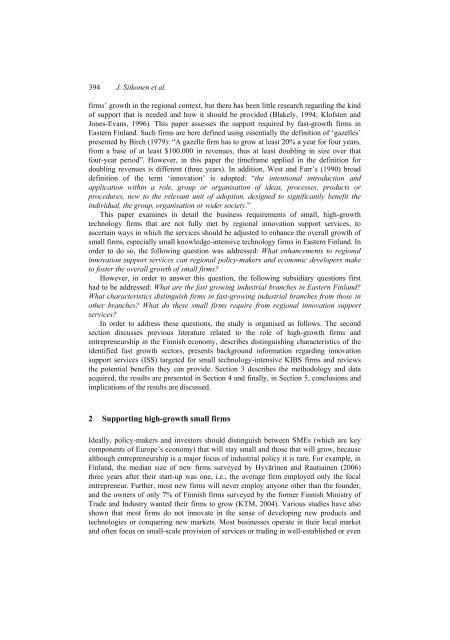dissertation in pdf-format - Aalto-yliopisto
dissertation in pdf-format - Aalto-yliopisto
dissertation in pdf-format - Aalto-yliopisto
Create successful ePaper yourself
Turn your PDF publications into a flip-book with our unique Google optimized e-Paper software.
394 J. Siikonen et al.<br />
firms’ growth <strong>in</strong> the regional context, but there has been little research regard<strong>in</strong>g the k<strong>in</strong>d<br />
of support that is needed and how it should be provided (Blakely, 1994; Klofsten and<br />
Jones-Evans, 1996). This paper assesses the support required by fast-growth firms <strong>in</strong><br />
Eastern F<strong>in</strong>land. Such firms are here def<strong>in</strong>ed us<strong>in</strong>g essentially the def<strong>in</strong>ition of ‘gazelles’<br />
presented by Birch (1979): “A gazelle firm has to grow at least 20% a year for four years,<br />
from a base of at least $100.000 <strong>in</strong> revenues, thus at least doubl<strong>in</strong>g <strong>in</strong> size over that<br />
four-year period”. However, <strong>in</strong> this paper the timeframe applied <strong>in</strong> the def<strong>in</strong>ition for<br />
doubl<strong>in</strong>g revenues is different (three years). In addition, West and Farr’s (1990) broad<br />
def<strong>in</strong>ition of the term ‘<strong>in</strong>novation’ is adopted: “the <strong>in</strong>tentional <strong>in</strong>troduction and<br />
application with<strong>in</strong> a role, group or organisation of ideas, processes, products or<br />
procedures, new to the relevant unit of adoption, designed to significantly benefit the<br />
<strong>in</strong>dividual, the group, organisation or wider society.”<br />
This paper exam<strong>in</strong>es <strong>in</strong> detail the bus<strong>in</strong>ess requirements of small, high-growth<br />
technology firms that are not fully met by regional <strong>in</strong>novation support services, to<br />
ascerta<strong>in</strong> ways <strong>in</strong> which the services should be adjusted to enhance the overall growth of<br />
small firms, especially small knowledge-<strong>in</strong>tensive technology firms <strong>in</strong> Eastern F<strong>in</strong>land. In<br />
order to do so, the follow<strong>in</strong>g question was addressed: What enhancements to regional<br />
<strong>in</strong>novation support services can regional policy-makers and economic developers make<br />
to foster the overall growth of small firms?<br />
However, <strong>in</strong> order to answer this question, the follow<strong>in</strong>g subsidiary questions first<br />
had to be addressed: What are the fast grow<strong>in</strong>g <strong>in</strong>dustrial branches <strong>in</strong> Eastern F<strong>in</strong>land?<br />
What characteristics dist<strong>in</strong>guish firms <strong>in</strong> fast-grow<strong>in</strong>g <strong>in</strong>dustrial branches from those <strong>in</strong><br />
other branches? What do these small firms require from regional <strong>in</strong>novation support<br />
services?<br />
In order to address these questions, the study is organised as follows. The second<br />
section discusses previous literature related to the role of high-growth firms and<br />
entrepreneurship <strong>in</strong> the F<strong>in</strong>nish economy, describes dist<strong>in</strong>guish<strong>in</strong>g characteristics of the<br />
identified fast growth sectors, presents background <strong>in</strong><strong>format</strong>ion regard<strong>in</strong>g <strong>in</strong>novation<br />
support services (ISS) targeted for small technology-<strong>in</strong>tensive KIBS firms and reviews<br />
the potential benefits they can provide. Section 3 describes the methodology and data<br />
acquired, the results are presented <strong>in</strong> Section 4 and f<strong>in</strong>ally, <strong>in</strong> Section 5, conclusions and<br />
implications of the results are discussed.<br />
2 Support<strong>in</strong>g high-growth small firms<br />
Ideally, policy-makers and <strong>in</strong>vestors should dist<strong>in</strong>guish between SMEs (which are key<br />
components of Europe’s economy) that will stay small and those that will grow, because<br />
although entrepreneurship is a major focus of <strong>in</strong>dustrial policy it is rare. For example, <strong>in</strong><br />
F<strong>in</strong>land, the median size of new firms surveyed by Hyvär<strong>in</strong>en and Rautia<strong>in</strong>en (2006)<br />
three years after their start-up was one, i.e., the average firm employed only the focal<br />
entrepreneur. Further, most new firms will never employ anyone other than the founder,<br />
and the owners of only 7% of F<strong>in</strong>nish firms surveyed by the former F<strong>in</strong>nish M<strong>in</strong>istry of<br />
Trade and Industry wanted their firms to grow (KTM, 2004). Various studies have also<br />
shown that most firms do not <strong>in</strong>novate <strong>in</strong> the sense of develop<strong>in</strong>g new products and<br />
technologies or conquer<strong>in</strong>g new markets. Most bus<strong>in</strong>esses operate <strong>in</strong> their local market<br />
and often focus on small-scale provision of services or trad<strong>in</strong>g <strong>in</strong> well-established or even
















